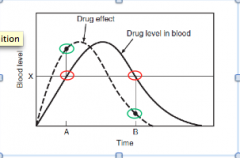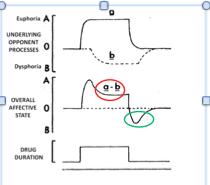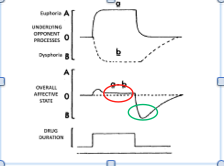![]()
![]()
![]()
Use LEFT and RIGHT arrow keys to navigate between flashcards;
Use UP and DOWN arrow keys to flip the card;
H to show hint;
A reads text to speech;
41 Cards in this Set
- Front
- Back
|
absolutethreshold |
lowest detectable |
|
|
differencethreshold |
lowest level of detectable change |
|
|
•Increasein threshold |
sense not as good |
|
|
Lab Tests of Motor Performance |
•Simplereaction time (RT) •Complexreaction time (CRT) •Fingertapping •Handsteadiness •PursuitRotor Task (for hand eye coordination) |
|
|
Test for Attention and Vigilance |
•MackworthClock Test (this is an example)•Handon a large circular dial moves incrementally around the dial – if it skips astep, press the button (12 times every 30s)•Testfor radar operators in WWII (long task – 2 hours)••Importantmeasure is decrement observed after 30 min on task |
|
|
Workingmemory --> ________ --> longterm |
rehearsal |
|
|
N-backtest of working memory |
•(remember1-back, 2-back etc) •Canbe done with objects or a string of letters/numbers |
|
|
Implicit |
procedural (ie. riding a bike) |
|
|
•Explicit |
declarative (ie. knowing what the bike is and how it should work) |
|
|
Episodicmemory |
•explicitmemory that is particular to you (E.g.remembering when you first rode a bike) |
|
|
Tests of LTM (implicit, explicit, episodic) |
includefree or cued recall of word lists |
|
|
disinhibition |
Somedrugs prevent inhibition of actions |
|
|
Tests of inhibitory control |
Go-nogo & Go-stop |
|
|
Go-stop |
•moredifficult; withhold response if a stop signal appears right after the go signal(delay is manipulated) ØDeterminedelay at which person can respond correctly 50% of the time ØAlcohollengthens the delay |
|
|
Go-nogo |
– only respond to one of the stimuli (a light or symbol); ‘no-go’ infrequently presented |
|
|
Measures for driving tests |
•Drivein real traffic with driving expertØProblems– different experiences, impairment in the drug condition (ethics) •Closeddriving course (safer, easier to make comparisons) ØProblem– cannot tell why errors occur (e.g., car or RT?)•Drivingsimulators |
|
|
What is the definition of tolerance? |
•Adecrease in effectiveness or potency of a drug based on repeatedadministrations•OR••Theneed to increase the dosage of a drug to maintain its effectiveness. |
|
|
Main Characteristics of Tolerance |
•Itdoes not last indefinitely •Astolerance develops, drug effects may disappear at different rates (due toenvironment or circumstances) ØE.g.alcohol •Toleranceto one drug may reduce effect of another drug (cross tolerance) ØE.g.opioids •Tolerancedevelopswhen the drug disrupts homeostatic mechanisms |
|

WHat is this & describe. |
Model of AcuteTolerance; Note:Drug level in blood is same at Time A and Time B. (red circles); However,the drug effect differs for the two time points.(greencircles); Thisis thought to illustrate tolerance that can developaftera single administration. An example is alcohol. |
|
|
Acute Tolerance |
develops with one administration |
|
|
•Metabolic Tolerance |
increase in ability to metabolize (change in enzyme induction) --> less drug available, all effects reduced |
|
|
•Physiological Tolerance |
results from body’s effort (through compensatory processes) to restore homeostasis after detection of the drug --> progressively smaller effect of drug ØE.g. upregulation and downregulation of neurotransmitters |
|
|
•BehaviouralTolerance |
through experience the animal learns to decrease the effect of a drug à conditioning |
|
|
Withdrawal |
changesthat occur when a drug is stopped or is reduced (usually within hours) |
|
|
cross dependence |
•Drugs in the same family have similar withdrawal – can therefore stop withdrawal using a different drug |
|
|
can you speed withdrawal? How? |
find in text |
|
|
Dependence |
•Twodefinitions ØStatewhere removing drug causes withdrawal ØStatewhere person takes drug compulsively •Originally, bothmeanings were taken together, the idea being that… [dependence = addiction]•Now, weknow that these two states can exist independently |
|
|
physical withdrawal |
State where removing drug causes withdrawal |
|
|
What is an explanation for the Relationship Between Toleranceand Dependence |
OpponentProcess Theory |
|
|
Opponent Process Theory |
ØTwo processes opposing each other (overlapping in time) ØE.g., excitatory & inhibitory ØIn the case of drugs, more like eurphoric vs. dysphoric Ø ØBoth processes happen during a single administration of a drug Ø ØProcess A = ’feel good’ effect of the drug ØProcess B = compensatory adjustments (once drug is gone, these are withdrawal symptoms) |
|

What does the graph say about opponent processes? A= good feeling, B = bad feeling brought on by compensation (builds up overtime) A-B= overall subjective effect |
One administrationAcutetolerance shown right away (red circle)Withdrawalshown after drug is gone (green circle) |
|

What does the graph say about opponent processes? A = good feeling, B = bad feeling brought on by compensation (builds up over time) A-B = overall subjective effect |
Multiple administrations (B isstronger & sooner)Increasedtolerance (red circle)Moreprominent and longer withdrawal (green circle) |
|
|
Give an example of the CompensatoryResponses/Withdrawal effects of alcohol |
ØDrinkingand feeling sick the next day, i.e., hangover ØManyof the effects (e.g., dehydration, stomach upset) are notcompensatory/withdrawalbut rather, are toxic effects ØLightsensitivity iswithdrawal |
|
|
Give an example of the Compensatory Responses/Withdrawal effects of cocaine |
ØDepressionafter dose wears off --> compensatory (i.e. happens because of the body’s efforts to restore homeostasisafter detection of the cocaine) |
|
|
•Toleranceand withdrawal are not _______(even though withdrawal consists ofcompensatory effects that cause tolerance) e.g.,Some long time drinkers who show tolerance but do not experience withdrawal •Why?________ ________ (nothing physiological)ØSlowelimination of drug from body, e.g., THC |
correlated ; Behavioural tolerance |
|
|
•Classical Conditioning ofDrug Effects |
•Drug effects can be conditioned to a neutral stimulus •Pavlov Øsound could elicit responses similar to drug responses ØInjection procedures could elicit drug-type responses Drug = UCS, Effects = UCR, Sound/injection prep = CS, Effects w/o drug = CR |
|
|
Classical Conditioning ofCompensatory Responses |
Drug= UCS, Effects= UCR, Sound/injectionprep = CS, Effectsw/o drug = CR [sometimesthe effect is the opposite of the UCR] •E.g.rats & morphineØUCR= analgesia (less response to pain)ØCR= hyperalgesia (increased sensitivity to pain) [with repetition]ØAnexplanationis that the compensatory response (↑sensitivity) has become the UCR |
|
|
Classical Conditioning of DrugTolerance |

ShepardSiegel at McMaster University (Hamilton, circa 1970s)Ratexperiments on hot plate: Øpawlick latency longer after morphine (analgesia)ØPawlick latency shorter with more administrations (tolerance), Toleranceonly seen in the environment where the drug was given. This is conditionaltolerance. |
|
|
Classical Conditioning ofWithdrawal |
•Whencompensatory responses occur in the absence of a drug they are known aswithdrawal symptoms••Howdoes this conditioning manifest?•E.g.some former heroin addicts (withdrawal already complete) can experiencewithdrawal symptoms when they return to places where drug effects wereexperienced |
|
|
Operant Conditioning of Tolerance, Campbell& Seiden(1973) |

•Demonstratedby a DRLschedule(differential reinforcement of low rates) •Reinforcementhappens only whenthe rat waits for a fixed period (reinforcement for a low response rate)ØE.g.rat loses reinforcement in presence of stimulants (can’t delay responding)•Researchersconcluded that rats learned and changed their behavior(conditioning of tolerance) |
|
|
conditioning of tolerance |
rats learned and changed their behavior |

